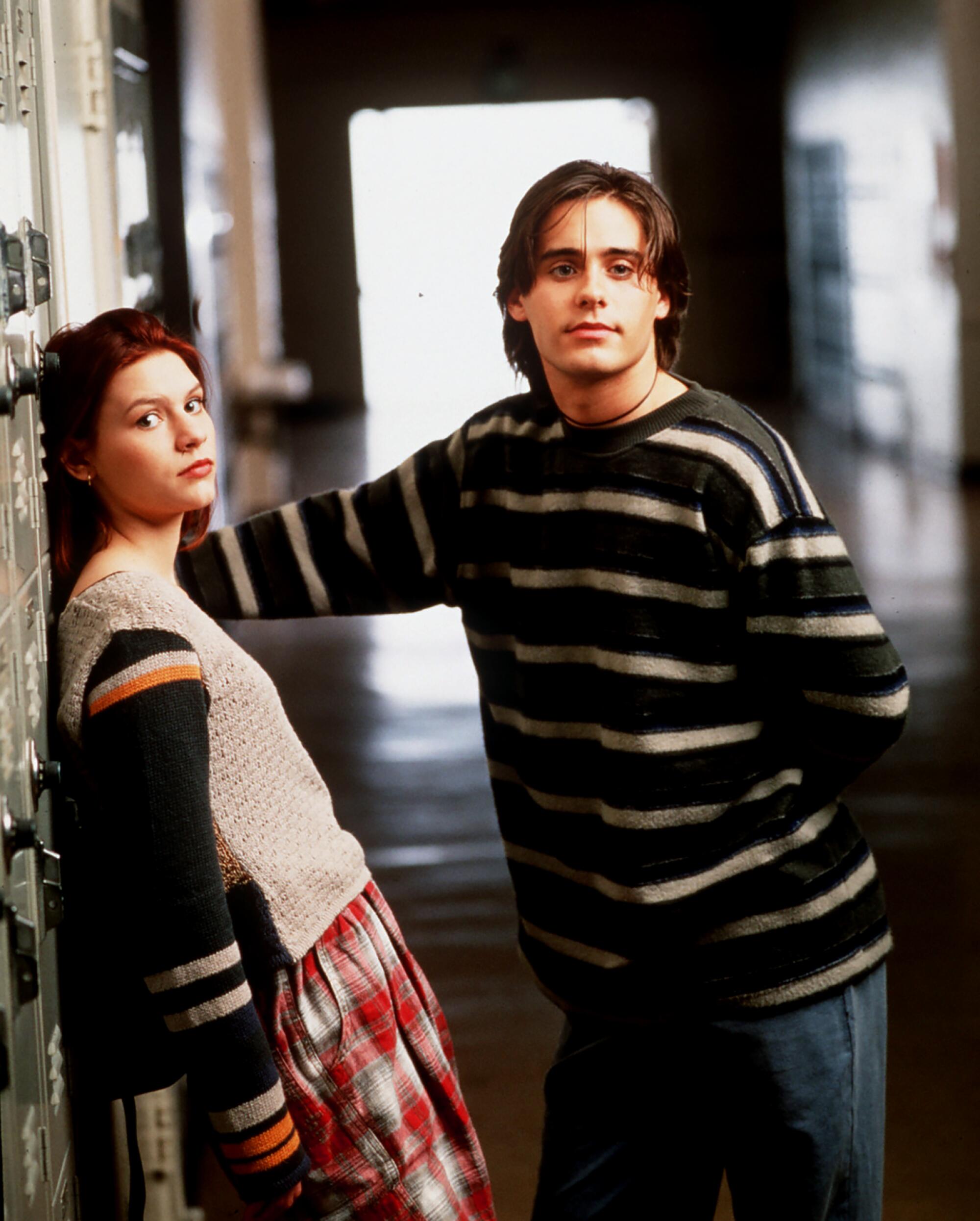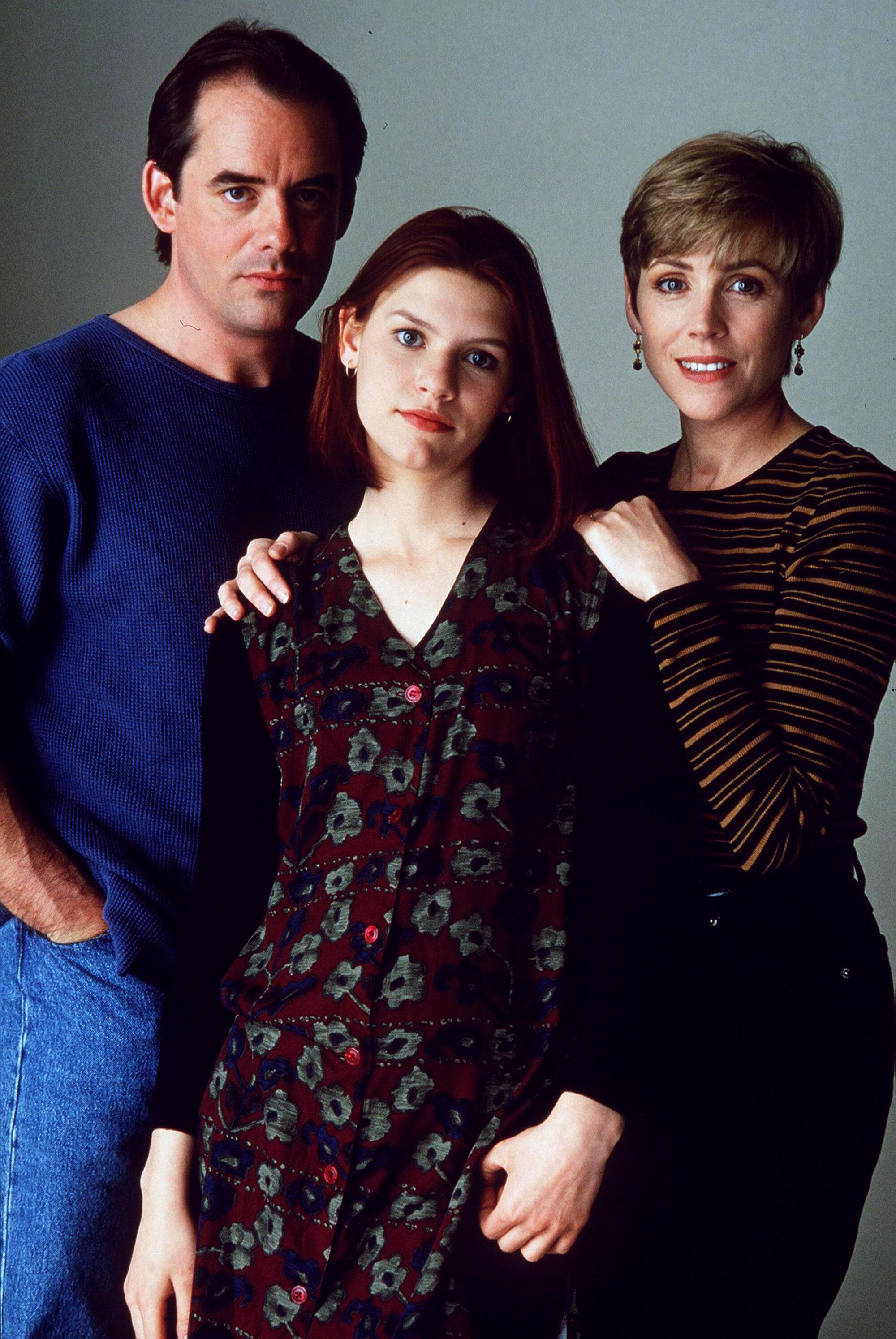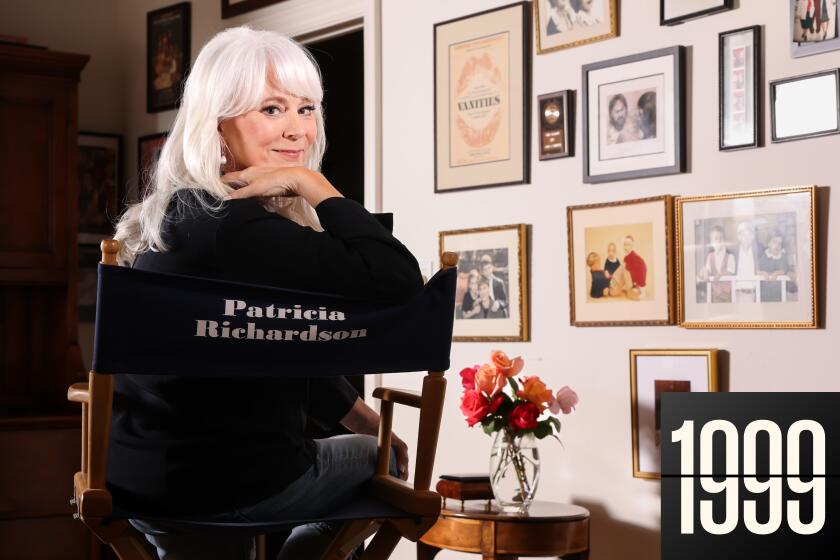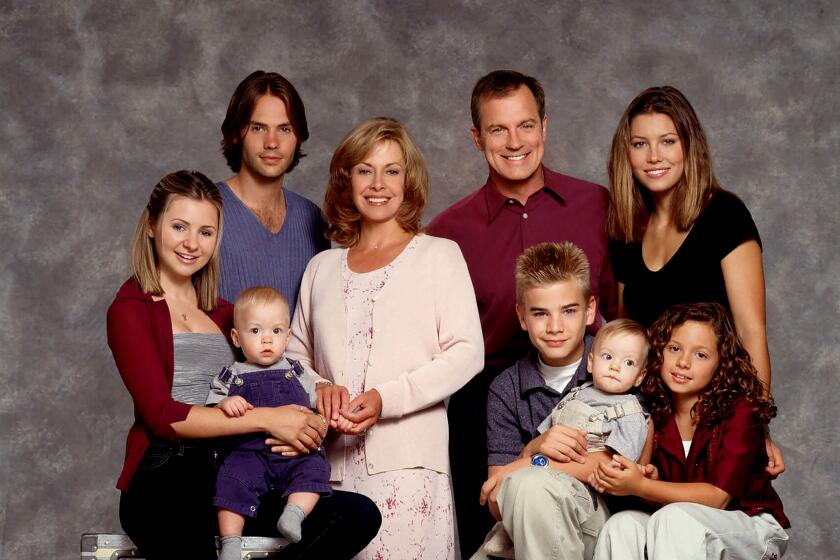
- Share via
In August 1994, “My So-Called Life” debuted on ABC and presented American viewers with a radically different version of adolescence than had ever been seen on television. Set in suburban Pittsburgh, the coming-of-age drama starred Claire Danes as Angela Chase, an angsty 15-year-old sophomore with a wardrobe of flannel and hair dyed a Manic Panic red. What made the series unique wasn’t just Angela’s grungy style, it was the fact that the story unfolded from her point of view. In voice-over narration, Angela communicated directly to the audience and shared her innermost thoughts — sometimes eloquent, sometimes inane but always authentic to the volatile experience of being a teenager.
The show, from executive producers Marshall Herskovitz and Edward Zwick — creators of the polarizing yuppie drama “Thirtysomething” — was a critical darling that floundered in its initial run on ABC and landed near the bottom of the Nielsen ratings. Despite fans who used AOL message boards to wage a first-of-its-kind online campaign to save the show and a novel attempt to reach younger audiences by airing reruns on MTV, “My So-Called Life” was canceled in May 1995, after just 19 episodes.
A few months later, “My So-Called Life” was named best drama series of the 1994-95 season by the Television Critics Association. In her acceptance speech, creator Winnie Holzman noted a dark irony: one of the most heavily anticipated shows coming to ABC that fall was “Murder One,” a drama from mega producer Steven Bochco following the murder of a 15-year-old girl. A shocking sequence in the pilot depicted her naked, bound body. The character was never seen alive.
“There are some people who feel more comfortable with a 15-year-old girl stripped and slaughtered,” Holzman told the audience of journalists, “than one who is alive and speaking her own mind.”
Thirty years after its short but memorable run on network television, “My So-Called Life” is widely regarded as a miraculous one-season wonder and a touchstone of ’90s popular culture that perfectly captures the era’s competing strains of irony and earnestness.

The show instantly established Danes, who was just 13 when she was cast in the pilot and earned an Emmy nomination for the role, as one of the finest actresses of her generation. It also launched the career of future Oscar-winner Jared Leto, who played Angela’s monosyllabic love interest, Jordan Catalano. Thanks to cable reruns, DVD box sets, streaming and now social media clips, the show’s reputation has only grown over the last three decades. It is firmly ensconced in the TV canon with other bold, inventive, gone-too-soon network shows of the era, like “Twin Peaks.”
But the comments Holzman made to critics back in 1995 — not widely noted at the time — are part of a deeper, overlooked story about the legacy of “My So-Called Life,” she told The Times in a recent interview. “Angela didn’t present in a way that men understood. She wasn’t there or on display for their pleasure,” Holzman said. Unlike so many other young women on television, then and now, “she was a sexual creature, not a sexual object.”
The show was revolutionary — and considered too “difficult” to market to the American public — because of how it brought the young, female gaze to television and encouraged audiences to identify with Angela as she (mis)behaved in ways typically reserved for adolescent males in pop culture. She lusted after someone who was physically attractive but beneath her intellectually. She ignored Brian Krakow (Devon Gummersall) the smart boy across the street who clearly adored her. She ghosted her goody-two-shoes best friend Sharon Cherski (Devon Odessa) to hang out with an edgier crew, including bad girl Rayanne Graff (A.J. Langer) and the queer, eyeliner-wearing Rickie Vasquez (Wilson Cruz). Angela Chase was a flawed female protagonist who both challenged and thrilled viewers long before Fleabag, Hannah Horvath — or, for that matter, Carrie Bradshaw.
Reflecting 25 years after the ‘Home Improvement’ finale, the actor says there’s a reason the sitcom that co-starred Tim Allen isn’t part of the ’90s nostalgia wave: ‘It’s about his politics.’
“My So-Called Life” was born out of Zwick and Herskovitz’s frustrated attempts to portray teenagers authentically on TV. Zwick got his start on the ABC domestic drama “Family,” which starred Kristy McNichol as a tomboy named Buddy Lawrence. Executive producer Leonard Goldberg would often send notes on his scripts reading “N.O.B.,” which stood for “not our Buddy,” and meant that he’d written dialogue that was too confrontational and off-putting.
Later, Herskovitz wrote a pilot for Showtime called “Secret Seventeen,” about a 15-year-old boy who didn’t fit in with the dominant mall-centric teen culture of the ’80s. “I wanted to do something that was told from the inside of the teenage experience, as opposed to exploiting the teenage experiences, which is all you saw on television at that time,” he said. Despite its promise, the project was killed when a new administration took over Showtime.

Within a few years, Zwick and Herskovitz were working together on “Thirtysomething,” the ABC drama following a group of disillusioned baby boomers as they came to terms with their middle-class lives. Holzman was a standout writer who’d been hired after submitting a spec script through her brother, a cinematographer on the series. Herskovitz and Zwick “encouraged people to bring their own voice and their own ideas,” Holzman said. “Expressing what actually mattered to you on TV — what a concept! But back then, it was a very unusual idea.”
Though the series was never a massive ratings hit, it was popular with the kind of affluent, educated professionals it portrayed, and sparked lively debate about the shifting values of the “Me” generation. “The biggest lesson of ‘Thirtysomething,’ was that it meant a lot to people to feel like they were seeing aspects of themselves on television,” Holzman said.
After that series ended, they were keen to work with Holzman again and revived their idea for a series that portrayed the teenage experience truthfully. As a creative experiment, Holzman wrote several pages of a diary in the voice of a teenage girl.
The pages, nearly all of which made it into the pilot of “My So-Called Life,” “were astonishing,” Herskovitz said. “She had no story, no character, no family — nothing. She just had a voice of this girl, and from that voice everything followed. It was incredibly exciting to read, because you had never heard that voice on television before.” Holzman, who was then nearing 40, had “the most extraordinary ability to remember the details of what it’s like to be in high school, like the wax paper that the teachers used to wrap up their apples,” Herskovitz said.
“Here was a teenager whose inner life was every bit as interesting and as arresting as any adult,” Zwick said, noting that part of what made Angela so intriguing was her unreliability. Her narrated version of events often contradicted or glossed over what we saw on screen. Other times, she was “willing to admit things that were shameful, embarrassing or discomforting,” he added. In a glaring example from the pilot episode, Angela says that Anne Frank was “lucky” because she got to be “stuck in an attic for three years with this guy she really liked.”
Of course, the producers had to find a performer gifted enough to channel Angela’s distinctive voice in convincing fashion. In the ’90s, “There was no teenager ever playing a teenager on television,” Zwick recalled.

“My So-Called Life” required a more authentic approach. When Danes was cast in the series, she was an unknown who had acted in a single episode of “Law & Order.” (She nearly lost the part to Alicia Silverstone, who auditioned immediately before her.) Because Danes was only 13 when she started the show, her hours on set would have to be limited to comply with child labor laws. As a result, producers had to ramp up storylines involving other characters, particularly her parents Patty (Bess Armstrong) and Graham (Tom Irwin), who experience a rocky patch in their marriage.
Danes impressed everyone with her preternatural gifts as an actor, to the extent that “we were all so afraid of her when we did the show,” Herskovitz said. Not afraid like she was going to explode at them, but in awe of her abilities. In particular, he recalled the way Danes was able to channel intense emotions, on cue, in take after take. “It was like, this person is from another planet, because no 13-year-old could do what she was doing, which was not just completely real and authentic, but repeatable.”
The pilot captured Angela in a state of rebellious transformation: she dyes her mousy hair crimson, lies to her parents about her plans, goes to a nightclub with Rayanne and gets caught by the police, who drive her home. She is intensely dramatic and also strangely hostile to the people who love her the most — her parents. Over dinner with her family, we hear Angela’s thoughts: “Lately, I can’t even look at my mother without wanting to stab her repeatedly.”
“Angela Chase goes to such dark places, which is so much of what being a teenager is,” Herskovitz said. “As much as it’s full of excitement or joy, there’s also just incredible misery.”
ABC executives were excited by the episode when they saw it in April 1993. But instead of putting the series on the air that fall, network schedulers waited more than a year as they tried to find the right time slot for it. ABC ordered a handful of episodes every few months, heightening the uncertainty for all involved. “It took us two years to do 19 episodes. They would pick us up — six here, five there — in these little dribs and drabs. It was very, very difficult,” Herskovitz said.
Even before it aired, press coverage of “My So-Called Life” emphasized what a hard sell it would be with audiences, seemingly because it centered on a teenage girl who was not a bubbly, compliant cheerleader: In October 1993, nearly a year before it premiered, the New York Times ran a story detailing ABC’s reluctance to put it on the schedule. The network finally did in August 1994, three weeks before the start of the fall season, hoping that it would benefit from a head start. That didn’t work.

It had the misfortune of airing on Thursdays at 8 p.m., opposite NBC’s witty sitcom “Mad About You” and a promising new show called “Friends.” Reviews were mostly positive, occasionally ecstatic, with Danes’ performance often singled out for its brilliance. But the praise was not unanimous, and the criticism often felt tinged with disdain for the show’s protagonist. Several reviews complained about Angela’s “whiny” personality and made unfavorable comparisons to Holden Caulfield, the unreliable adolescent male narrator of “The Catcher in the Rye.”
Nearly as soon as “My So-Called Life” debuted, the press began to speculate about why it wasn’t finding an audience and how long it would take for ABC to pull the plug. In November 1994, Times’ Howard Rosenberg presented a number of theories about the show’s “ratings abyss,” including the possibility that it created such a “painful mirror image of adolescence,” it was uncomfortable to watch.
“One of the things ABC would say to me during that year was, ‘I don’t know, the show makes some people uncomfortable.’ Well, look how comfortable people are with dead naked girls,” Holzman said. “They definitely used the word ‘dark’ and sometimes they would say, ‘Isn’t it a little depressing?’ Now, let me think. What is depressing about it? Is it that she isn’t always smiling? It’s like that thing [people say to women on the street], ‘Smile, you’re so pretty.’ ”
A defining aspect of the show was Angela’s obsession with Jordan Catalano, who took his coffee “black with three or four sugars,” played in a band called the Frozen Embryos and was always referred to by his full name. She projects emotional complexity onto Jordan, who is about as deep as a wading pool. (“He’s always closing his eyes like it hurts to look at things,” Angela says in the pilot, as Jordan stands at his locker, dropping Visine in his eyes — probably because he’s stoned.)
Nearly 30 years after the WB family drama premiered, three of its former child stars are sharing memories and wrestling with its legacy on their podcast “Catching Up With the Camdens.”
In a standout episode of the series, “Self Esteem,” Angela skips geometry review to make out with Jordan in the school boiler room, but grows frustrated as he refuses to acknowledge their relationship in public. She is both recklessly horny and profoundly insecure — a combination that any former adolescent girl can understand.
ABC took a hands-off approach to the show, and rarely meddled with its content, even when “My So-Called Life” dabbled in controversial issues like gun violence. (In one prescient episode, a student brings a loaded weapon to school and accidentally fires it, triggering a wave of panic.) However, network executives “didn’t know how they were going to program the show, because the audience of teenage girls meant nothing to them,” Herskovitz said.

“They said to us, literally, ‘We just don’t think there’s a real teenage audience to be mined in television,’ “ Zwick said.
Still, it cannot be said that ABC didn’t try to save the show. The network arranged to air reruns on MTV beginning in April 1994, in hopes that it would reach younger viewers. At one point, Zwick met with Bob Iger, then president of entertainment at ABC, and urged him to renew the show. But it was Danes who ultimately decided she was ready to move on after several years in limbo.
Danes soon appeared in “Romeo + Juliet,” with Leonardo DiCaprio, another actor who’d risen to fame as a precocious child star on ABC. That film’s box office success served as evidence that “My So-Called Life’” had the misfortune of being ever-so-slightly ahead of its time. In January 1995, the final episode of the series aired on ABC; that same month, the WB and UPN made their debut. The networks recognized the value of younger viewers and ushered in a golden age of teen dramas like “Felicity” and “Dawson’s Creek.” And then came “Titanic,” which forever proved the ferocious consumer power of young female fans.
“Back then was before people had tapped into the idea of a teenage girl meaning anything in the market,” said Holzman, who wrote the book for the blockbuster musical “Wicked” and co-wrote the screenplay of the recent film adaptation. “The truth is that very soon after that, things shifted. People started to understand that this was a market that you could go after.” The intimate style of voice-over that made “My So-Called Life” so groundbreaking became almost a prerequisite in subsequent female-centered shows, from “Sex and the City” and “Fleabag” to “The Handmaid’s Tale.”
For Holzman, the show’s ending was bittersweet — and not only because it left Angela’s romantic future unresolved. Though she appreciated the support “My So-Called Life” received from fans, she was also grateful to have made the show at all, and bristled at the idea it was a “failure” because it only lasted a single season. After all, there are plenty of great ideas that never make it further than the pages of a script. “I had to examine what success meant to me,” she said. “It was really liberating to be able to say, ‘I know that that was a success for me. That experience was complete in itself and beautiful in itself.’ ”
More to Read
The complete guide to home viewing
Get Screen Gab for everything about the TV shows and streaming movies everyone’s talking about.
You may occasionally receive promotional content from the Los Angeles Times.








